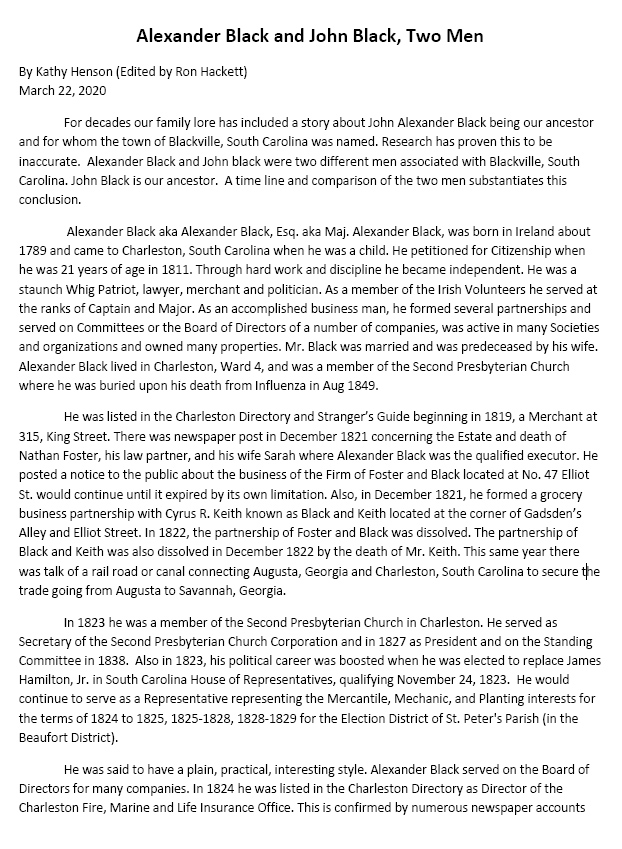| Notes |
- The information in this note has been compiled from family stories and notes, but contains some inaccurate information. The most significant is the conflating of John Black and Alexander Black. They are two different and unrelated individuals. Blackville, South Carolina is named for Alexander Black according to research by Kathy Black Henson.
-----
John Alexander Black was born in 1810 in Glasgow, Scotland, a city of Western Scotland, on the Clyde River. He supposedly ran away before coming of age and came to America by boat to Charleston, South Carolina in the early 1830's. He lived with a family named Mr. & Mrs. Peters for a while. He traveled with his two brothers, Jo and Bruce. Once the reached America, they went their separate ways. Jo became a tailor and settled in Louisiana. There is no information on Bruce.
He may have lived with a sister, Mrs Permelia Redman, who lived in Barnwell County, in the vicinity where Blackville is located. (note: this is probably a church sister and not a familial relationship)
John Alexander Black came to a sparsely settled section and settled. This section is now known as Blackville, but was once named Clinton.
John's plantation was joining Dr. Montague near the Methodist Church. John Built the first house and blacksmith shop in Blackville. He and Dr. Montague lived side by side in the 1850 census.
John helped build the railroad between Charleston and Hamberg, now North Augusta, SC. In the census, he states he was a mechanic and carpenter.
John Alexander was one of the first Presidents and Chairman of the Board of Southern Railroad and Canal Company.
Blackville was named for John Alexander Black, who petitioned the South Carolina legislature for the charter of the South Carolina Railroad & Canal Company, once named Clinton.
Seven years later the railroad from Charleston to Augusta was surveyed over a route passing Mr. Black's home.
The railroad from Charleston, South Carolina to Augusta, Georgia was the longest in the world under one management. In fact, it was twice as long as any in America. It was the first commercial railroad in the United States.
The building of the railroad was an engineering and economic success.
The committee members were Alexander Black, Joseph Johnson, William Aiken, James Ross, J. N. Cardogo, and T. Tupper.
The length of the route was to be about one hundred and forty miles. The estimated cost per mile for construction was placed at $3,600.00, and the total cost for the whole line being $504,000.00. Rolling stock, bridges, and maintenance sheds would add another $96,000.00 making the total $600,000.00. This was a large sum of money, but the annual return on investment was thought to be 19% (copy from Charleston, SC Archives).
The railroad attracted settlers and this soon became a prosperous community. Blackville was recognized in 1837 for John Alexander Black.
"The Best Friend" of Charleston was the first railroad locomotive in South Carolina, first commercial railroad in United States, and first steam locomotive built in America.
This railroad was taken up in 1992.
John Alexander married first to Gemima Givens in 1835. Gemima was born in 1820, and died in 1852. She was a daughter of Eli Givens.
John married second to Elizabeth "Betsey" Conoway in 1855. Elizabeth was born April 2, 1828 and died December 6, 1904.
In the 1860 census, John's personal property was $150.00. Real estate was $200.00.
In later years John and Elizabeth bought seventy five acres of farm land between Blackville and Hilda. They built a house on this land and they farmed for a living.
John died in 1875 in Blackville South Carolina, and is buried in the Blackville Methodist Church cemetery. He was placed by the side of Dr. Montague.
John had no marker, so we do not have the accurate date. A stake was seen on his grave. Gemima may be buried near him, but we are not sure. Elizabeth is buried in the Double Pond Cemetery near Blackville.
The 1850 census states when the first six children were born.
|
 House of Hackett
House of Hackett

 d. 1855, Glasgow, Scotland
d. 1855, Glasgow, Scotland  (Age 71 years)
(Age 71 years)  d. 28 Dec 1914, Fairfax, SC
d. 28 Dec 1914, Fairfax, SC  (Age 68 years)
(Age 68 years)
